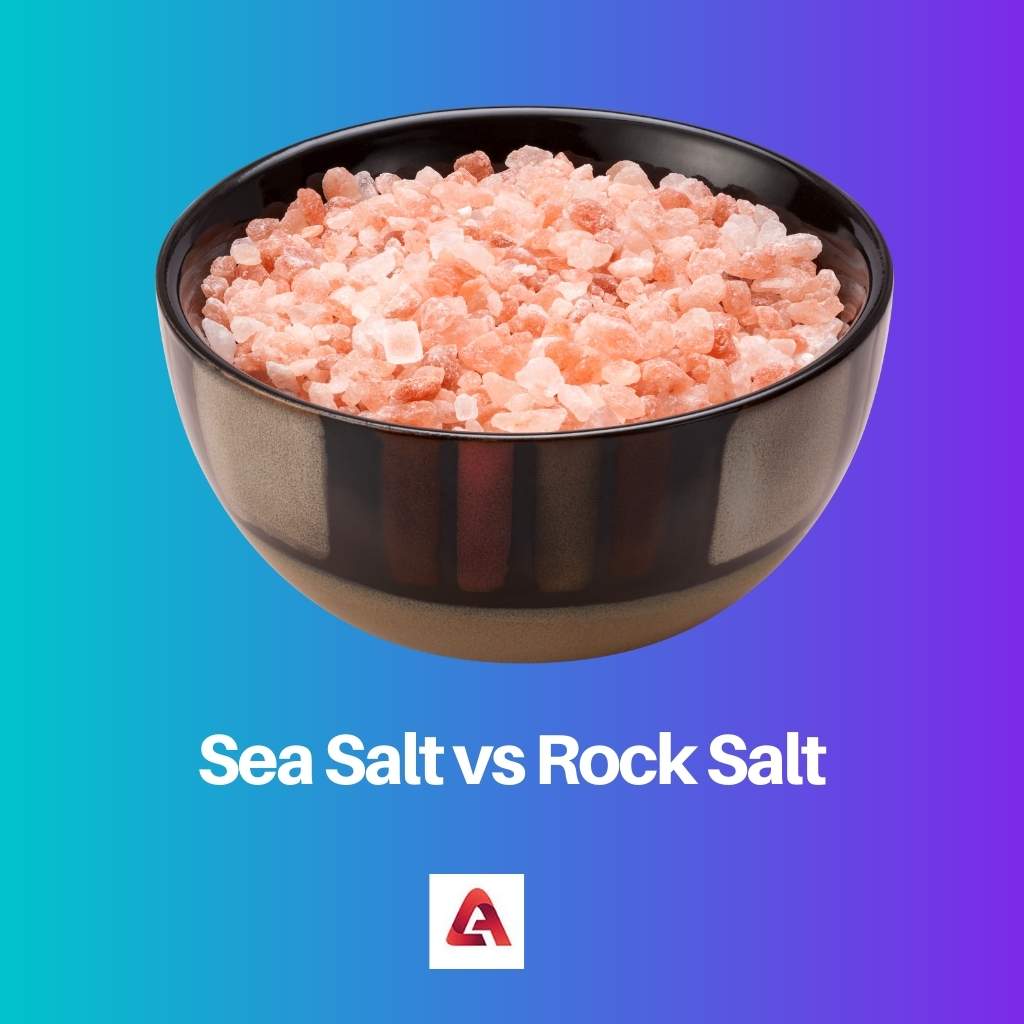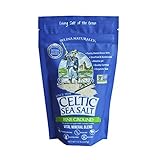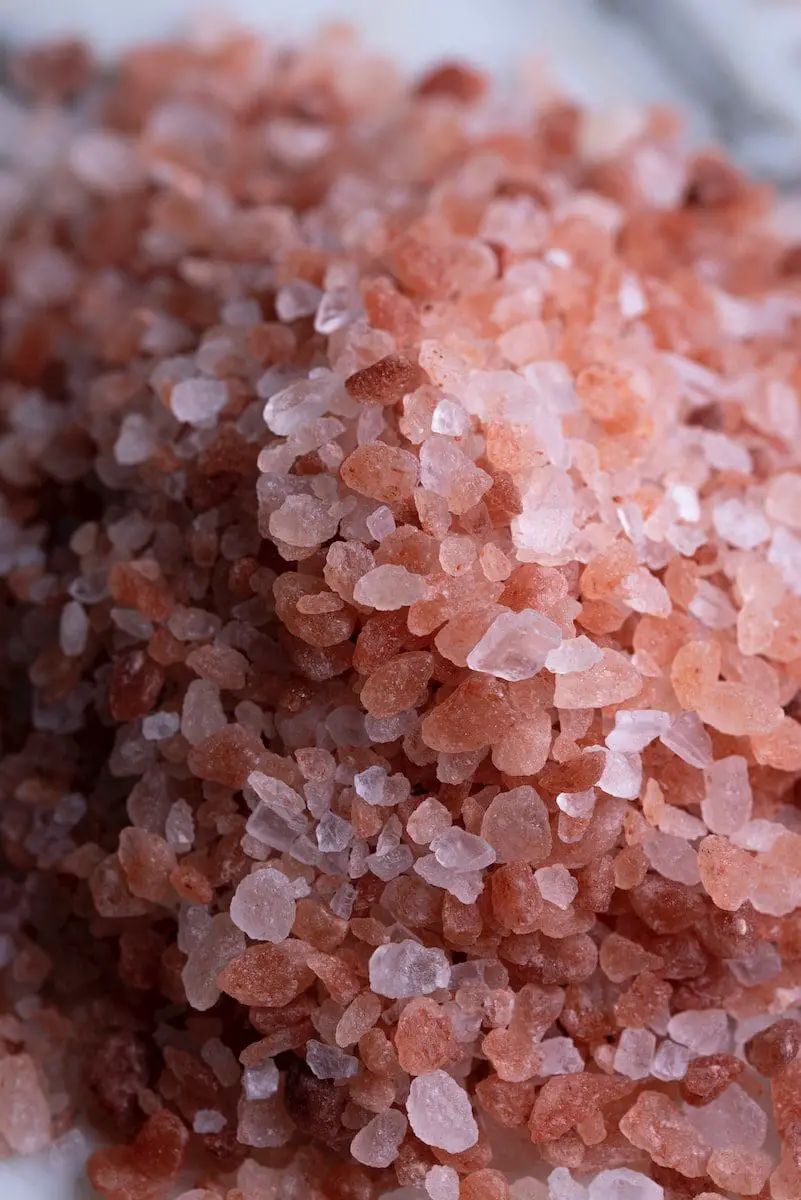Salt is an essential component of the food we eat. No dishes can be cooked without a pinch of salt in them.
Two types of salts can be used in food for different purposes. These are sea salt and rock salt.
Both have a unique combination of essential minerals for the body.
Key Takeaways
- Sea salt originates from evaporated seawater, while rock salt comes from underground mines.
- Rock salt contains more impurities and has a stronger flavor than sea salt’s milder taste.
- Sea salt is richer in trace minerals due to its natural source, giving it potential health benefits over rock salt.
Sea Salt vs Rock Salt
The difference between sea salt and rock salt is that sea salt is obtained through evaporation Of the ocean water. On the other hand, rock salt is collected from the ocean, and it is already in a consumable form.

Sea salt is obtained from various seas around the world. It is responsible for adding a pinch of saltiness to the food we eat.
Seawater is allowed to evaporate and leave tiny grains behind. These grains later form rock salt.
Rock salt is mainly found in different bodies of water. It is gathered from the world’s oceans.
Salt rocks are formed near the oceans due to a high concentration of minerals. It occurs in the form of solid rocks.
Comparison Table
| Parameters of comparison | Sea Salt | Rock Salt |
|---|---|---|
| Source of salt | It is mainly gathered from different seas around the world. | It is gathered from underground rocks formed near oceans. |
| Physical appearance and feel | The sea salt is mainly off-white but occurs in a variety of colors. It feels like tiny flakes. | Rock salt is grey or pink. It occurs in the form of large crystals of varying sizes. |
| Uses and applications | It can be used as an additive for different food products. It is also used in beauty products. | It is used in the process of making ice creams of different flavors. It is also used for melting ice. |
| Flavoring properties | It is not very strong in terms of flavor. It is mildly salty and can be easily used. | Rock Salt has a very strong flavor and needs to be used carefully. |
| Mineral Composition | Sea salt has a variety of minerals including Iodine, magnesium, sulfur call mom sodiu, and chlorine. | Rock salt is mainly sodium chloride and the other minerals are in very small quantities. |
What is Sea Salt?
Sea salt is an important ingredient in the food we eat. It is found in tiny bottles on the dining table of every house.
It is made by evaporating seawater and allowing it to crystallize into tiny flakes. Earlier, the method used for obtaining sea salt was quite complicated.
Now, with improving technologies, the process has simpler.
A lot of people are shifting towards using sea salt instead of table salt. One of the major reasons for this outcome is the increased amount of minerals.
Table salt is heavily ground, which causes a lot of minerals to wear out. The minerals obtained from sea salt are in adequate quantities and help maintain the overall health of the body.
It is speculated that sea salt can help maintain normal blood pressure and hydration levels in the body. This is caused by the proper amounts of sodium which is responsible for maintaining ionic balance.
It can be sprinkled onto roasted foods for enhanced taste. Salt is also known to bring out the hidden flavours in desserts like cupcakes and cookies.
| # | Preview | Product | |
|---|---|---|---|
| 1 |

| Amazon Brand - Happy Belly, Sea Salt, Fine Ground, 1 pound (Pack of 1) | Check Price on Amazon |
| 2 |

| Celtic Sea Salt, Fine Ground, 8 Ounce | Check Price on Amazon |

What is Rock Salt?
Rock salt or Halite is obtained by mining underground rocks. It has a higher concentration of sodium chloride and undetectable quantities of other minerals.
The crystal particles of the salt can be a hassle to dissolve in food. It is found in less abundance as compared to sea salt because mines cannot be found everywhere.
It is found in the form of large crystals which are non-uniform in shape and size. It is said to have a large number of impurities and is therefore found in hues of grey.
Apart from using foods, it can also be used for industrial purposes. For instance, in countries where snowfall is a constant problem, rock salt comes as a saviour.
This is because it can effectively melt ice without wasting much time. It has a very strong flavour and is used in very small quantities.
It can put an enhanced flavour in various dishes. For instance, Himalayan rock salt is considered as one of the most healthy options for food.
| # | Preview | Product | |
|---|---|---|---|
| 1 |

| Morton Ice Cream Salt, Rock Salt, 4 Pound, Tub (Pack of 4) | Check Price on Amazon |
| 2 |

| Pro-Cure Rock Salt Bulk In Poly Bag 4 Lb | Check Price on Amazon |

Main Differences Between Sea Salt and Rock Salt
- Sea Salt, as the name suggests, is octane from the sea by evaporating the water. Rock salt is obtained by solidified rocks form over the years due to mineral deposits.
- Sea salt has a combination of a variety of minerals, while rocksalt mainly has sodium and chlorine. Different minerals can also be added to sea salt for enhanced quality.
- Sea salt is available in different colours ranging from pink to green. Rock salt appears grey in color.
- A mild flavour occurs in food with the use of sea salt. Rock salt has a strong flavour and should be used accordingly.
- Rock salt has industrial purposes while sea salt is in general, a kitchen ingredient.

- https://www.sciencedirect.com/science/article/pii/B9780444595621000268
- https://www.sciencedirect.com/science/article/pii/S0013795201000515

The detailed explanation of how sea salt and rock salt are obtained and their uses was enlightening.
Absolutely, the article provides a comprehensive understanding of both types of salt.
The article provided valuable information about the origins and characteristics of both sea salt and rock salt.
I found the descriptions of sea salt and rock salt to be very interesting. The uses of rock salt beyond culinary purposes were surprising to me.
Agreed, rock salt’s industrial uses are overlooked.
The information about sea salt contributing to maintaining normal blood pressure and hydration levels was impressive. Anything that can help maintain health is valuable.
I completely agree, the health benefits of sea salt are significant.
Absolutely, it’s fascinating to learn about the potential health benefits of sea salt.
The article provides a clear understanding of the origins, properties, and uses of sea salt and rock salt.
The details on how rock salt can be used for industrial purposes, particularly for melting ice, were quite intriguing. It’s not something we think about.
Yes, it’s an aspect of rock salt that’s overlooked.
I found the industrial uses of rock salt to be particularly thought-provoking.
The article effectively explains the differences in physical appearance and feel of sea salt and rock salt, making it easy to distinguish between the two.
Yes, the distinctions between sea salt and rock salt are quite clear.
I agree, the article provides a comprehensive comparison of the two salts.
The section on the mineral composition of sea salt and rock salt was particularly enlightening. It really shows the nutritional differences between the two.
I appreciate the thorough comparison table provided here, it makes it easy to understand the distinctions between sea salt and rock salt.
Yes, the table is a great addition and really helps to sum up the key differences.
Totally agree, the visual comparison of the two salts is very helpful.
This is a highly informative article detailing the differences between sea salt and rock salt, and their respective uses and mineral compositions.
I agree, it’s fascinating how these two types of salt are obtained and their unique qualities.